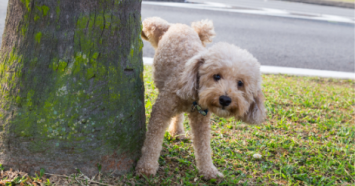
Collecting a urine sample from a dog can be a bit frustrating for many pet owners. Veterinarians often require the urine to be fresh, kept at a certain temperature, and caught in a special container. That’s a pretty big task when it comes to wiggly dogs who don’t understand how to urinate on command!
So why can’t you just bring in the blanket he peed on or the paper towel you used to soak it up from the floor? Urine samples are needed to check for many things:
Urine from a urinary tract infection (UTI) will have infection-fighting white blood cells and/or bacteria
If a bladder stone is suspected, your dog is peeing blood, or the pup is having trouble urinating,
Monitoring urine protein levels may be needed with certain diseases like kidney failure
Checking how dilute the urine is can help explain recent excess drinking and urinating
If you soak up urine off the floor or out of a rug, bacteria will most definitely be present. Dirt and fibers from the paper towel or rug can affect the protein and diluteness of the urine. If your floor had cleaning products on it, this can affect the number and type of bacteria seen. Thus, you need urine straight from the source, and it needs to go in a container that is as clean and sterile as possible, without any additional chemicals present.
Why does it need to be fresh? The longer the urine sits around, the more likely it is to grow bacteria, even if it doesn’t have bacteria in it at first. Further, if crystals are a concern, urine that sits around too long can develop crystals, which will skew the concentration and urine crystal results. Urine can also become more concentrated (i.e. less dilute) over time if some of the liquid has had time to evaporate.
How to Collect Dog Urine
Recognize that this can be a bit of a messy process. You will need to take the container given to you by your veterinarian (or a very clean container at home that you won’t need back) and hover it underneath your dog’s penis or vulva to try and catch a stream of urine when he or she uses the bathroom. It helps to have another person keep your dog on a leash when doing this, so you don’t have to chase him or her all over the yard.
Your dog may be pretty confused as to why you are in his or her space, so try not to get frustrated if he or she seems distracted by you. Just be patient, stay with your dog, and encourage him or her to go to the bathroom like you normally would.
It helps to try to collect urine at times your dog normally goes to the bathroom. As it is with a person, a dog’s bladder fills up with urine throughout the day as he or she drinks water. When the bladder is full, the dog feels the urge to go, signaling that it’s time to use the bathroom. If your dog doesn’t seem interested in urinating the first time you try to collect urine, take him or her back inside, offer normal amounts of water, and try again in an hour. If your dog urinates but you aren’t able to catch it in time, you may need to wait several hours before he or she needs to go again.
If all else fails, ask your veterinarian if you can leave your pet in their care for the day to collect urine. The staff usually has a bit more training in such matters, so it may not take them as long to be successful. If you do manage to collect enough urine (great job!), wash your hands, stick the urine container in the fridge (not the freezer), and try to get it to your vet within 24 hours (ideally as soon as possible). You don’t have to keep the urine cool if you are going straight to the veterinarian’s office, but if you can’t go immediately, keeping it cool will help the urine remain stable.